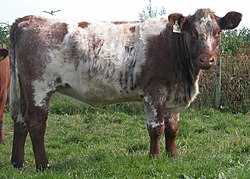Shorthorn
TheShorthornbreed ofcattleoriginated in the North East of England in the late eighteenth century. Thebreedwas developed as dual-purpose, suitable for both dairy and beef production; however, certain blood lines within the breed always emphasised one quality or the other. Over time, these different lines diverged, and by the second half of the twentieth century, two separate breeds had developed – theBeef Shorthorn,and theMilking Shorthorn.All Shorthorn cattle are coloured red, white, orroan,although roan cattle are preferred by some, and completely white animals are not common. However, one type of Shorthorn has been bred to be consistently white – theWhitebred Shorthorn,which was developed to cross with blackGalloway cattleto produce a popular blue roan crossbreed, theBlue Grey.
History
[edit]The breed developed from Teeswater and Durham cattle found originally in the North East of England. In the late eighteenth century, the Colling brothers,CharlesandRobert,started to improve the Durham cattle using the selective breeding techniques thatRobert Bakewellhad used successfully onLonghorn cattle.In 1796, Charles Colling of Ketton Hall, bred the famousDurham Ox.[1]The culmination of this breeding program was the birth of the bull Comet, bred by Charles Colling, in 1804. This bull was subsequently sold for 1000 guineas in 1810 at the Brafferton sale, the first 1000-guinea bull ever recorded. Related cattle may have been imported to the United States byHarry Dorsey GoughofBaltimore,Maryland,before 1808.[2]
At the same time, Thomas Bates of Kirklevington and John Booth of Killesby were developing the Teeswater cattle. The Bates cattle were subsequently developed for their milking qualities, whereas the Booth cattle were developed for their beef qualities. Animals taken to Scotland in 1817 from the Booth herd were used to produce the Beef Shorthorn breed.[1]
In 1822, George Coates published the first volume of his herd book; this was the first pedigree herd book for cattle in the world.[3]
Coates published the first four volumes, after which Henry Stafford took over the ownership and publishing of the herd book, retaining the nameCoates's Herd Book.The Shorthorn Society of Great Britain and Ireland was founded in 1874, and purchased the copyright of the herd book from Stafford. They have continued to compile and publishCoates's Herd Bookever since. TheAmerican Shorthorn Herd Bookwas the first to be published in the United States for any breed and was started in 1846, with the formation of the American Shorthorn Association following 26 years later in 1872.
Tibial hemimelia,a raregenetic disorder,was identified in Canada in 1999 in a small number of Shorthorn cattle, all descended from a single individual.[4]
Distribution
[edit]
Today, the breed is found mainly in English-speaking countries, and Southern South America. The main countries are:Argentina,Australia, Canada,New Zealand,Republic of Ireland,South Africa, United Kingdom, the United States of America,Uruguay,andZimbabwe.Beamish Museumin north-eastern England preserves the Durham breed.
Australia
[edit]Shorthorn cattle were one of the first purebred breeds to be imported into Australia when several cows were brought into New South Wales in 1800. More purebred Shorthorns were imported into NSW in 1825 by Potter McQueen ofScone.[3]Nine months later, theAustralian Agricultural Companyimported additional Shorthorns, and in the 1930s, Thomas Simpson Hall, the breeder of theHalls Heeler,imported Durham Shorthorns from which he developed extensive herds of Poll Shorthorns.[5]
The breed has a wide genetic base, resulting in the development of several distinct though closely related strains – these are the traditional strains:
- Beef Shorthorn
- Poll Shorthorn
- Durham
- Milking or Dairy Shorthorn
- Australian Shorthorn
The current Shorthorn Society of Australia encompasses the Poll Shorthorn, Australian Shorthorn, and Durham.[citation needed]
Shorthorns have contributed to the development of breeds such as theBelmont Red[3]andSanta Gertrudis.
References
[edit]- ^abFriend, John B.,Cattle of the World,Blandford Press, Dorset, 1978,ISBN0-7137-0856-5
- ^Goff, Phillip.The Four Goff Brothers of West Virginia: A New Perspective on Their Lives,pp. 65 ff.Masthof (Morgantown), 2003. Accessed 20 October 2013.
- ^abcBeef Breeders' Annual, AnInverell Timessupplement, Shorthorn breed arrived with the First Fleet, July 2008
- ^Tibial Hemimelia, Meningocele, and Abdominal Hernia in Shorthorn Cattle, J. M. Lapointe, S. Lachance and D. J. Steffen, Veterinary Pathology 37: 508 – 511, 2000Retrieved on 10 November 2008
- ^Howard, A. J. (Bert) (1990), "Halls Heelers", in Russel M. Warner (ed.),Over-Halling the Colony,Sydney: Southwood Press,ISBN0-908219-07-5
Breed associations
[edit]- The Shorthorn Society of United Kingdom & Ireland
- American Shorthorn Association
- Asociacion Argentina de Criadores de Shorthorn
- Shorthorn Association of Australia
- Canadian Shorthorn Association
- Irish Shorthorn Society
- New Zealand Shorthorn Association
External links
[edit]- Cattle breeds: Shorthorn
- The Shorthorn Breed of Cattle– Oklahoma State University
- Shorthorn Breed Information– Cattle.com
- The Durham Ox– painting of Comet, a Durham Shorthorn, 1804


